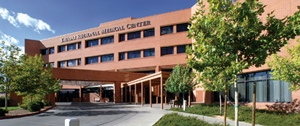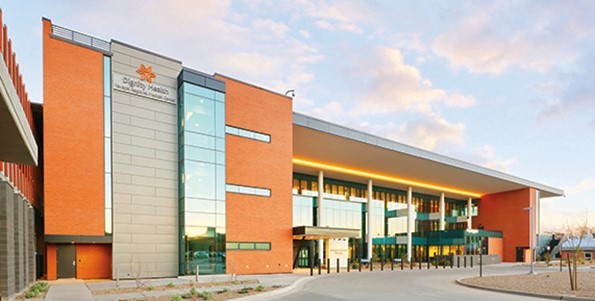The James Family Heart Center
1003 Willow Creek Road
Prescott, AZ 86301
928.445.2700

Yavapai Regional Medical Center
Heart Health
Diagnosis, treatment, surgery, rehabilitation, and education come together for coordinated and exceptional heart services at the James Family Heart Center at Dignity Health Yavapai Regional Medical Center.
Our multidisciplinary team includes cardiothoracic surgeons, cardiologists, interventional cardiologists, interventional radiologists, structural heart specialists, registered nurses, and more. State-of-the-art technology in the hands of this experienced team makes the James Family Heart Center northern Arizona’s premiere heart program.

Our premier heart team performs this lifesaving surgery, which restores normal blood flow to the heart by using a graft to bypass one or more blocked arteries. Coronary artery bypass surgery promotes:
Yavapai Regional’s hybrid operating room allows Heart Center specialists to diagnose patients using permanently integrated imaging equipment. Patients may then undergo a minimally invasive procedure or a surgical intervention in the same state-of-the-art hybrid operating room.
Instead of placing the patient on a heart-lung machine, our Heart Center surgeons perform this procedure while the heart is still beating, While not suitable for all patients, this method can reduce recovery time following coronary artery bypass surgery.
Major chest surgery may be recommended to treat lung conditions such as infection, cancer or emphysema. Some of these procedures can be performed using minimally invasive techniques.
This procedure is used to treat atrial fibrillation (rapid and disorganized heartbeat) by interrupting abnormal impulses between the upper chambers of the heart and allowing a return to a normal heartbeat.
This patient-centered program embraces a team approach to assess an individual patient’s blood management needs. PBM includes care plans that use pharmaceuticals, technology, and scientifically proven techniques to decrease blood loss and enhance blood cell production before, during, and after hospitalization. PBM prevents anemia, reduces complications, shortens hospital stays, and leads to better long-term outcomes.
The heart’s four chambers have the important job of ensuring blood flows in and out of the heart through its valves. During heart valve surgery, our surgeons repair or replace diseased heart valves so the valves can continue their important function in the heart.

1003 Willow Creek Road
Prescott, AZ 86301
928.445.2700

1001 Willow Creek Road
Suite 2200
Prescott, AZ 86301
928.445.6025

7700 East Florentine Road
Building B, Suite 206
Prescott Valley, AZ 86314
928.442.8117

1001 Willow Creek Road
Suite 2500
Prescott, AZ 86301
928.771.4752

1001 Willow Creek Road
Suite 3200
Prescott, AZ 86301
928.771.5595
Interventional procedures are minimally invasive, catheter-based treatment options for cardiology conditions throughout the body. That means, they do not require open surgery. Minimally invasive cardiology treatments have many benefits, including:

Angioplasty opens blockages in the heart that are caused by coronary artery disease, restoring blood flow to the heart without open heart surgery. During angioplasty, a long, thin tube (catheter) with a tiny balloon tip is put into a blood vessel and then guided to the blocked coronary artery. Once the catheter is in place, the balloon is inflated at the narrowed area of the artery. This presses the plaque or blood clot against the sides of the artery and restores blood flow to the heart.
Our heart specialists also use fluoroscopy during coronary angioplasty. Fluoroscopy is a special type of x-ray that’s like an x-ray “movie.” It shows blockages in the heart’s arteries as a contrast dye moves through the arteries.
Cardiac catheterization (also called cardiac cath or coronary angiogram) is an imaging procedure that tests for heart disease by allowing your doctor to “see” how well your heart is functioning. During the test, a long, narrow tube called a catheter is inserted into an artery or vein in your arm or leg. The catheter is then guided to your heart with the aid of a special x-ray machine. Contrast dye is injected through the catheter so that “movies” of your valves, coronary arteries and heart chambers can be created.
Cardiac electrophysiology is a subspecialty branch of cardiology. These physicians diagnose and treat heart rhythm disorders, also called arrhythmia.
Mitral regurgitation – when blood in the heart flows backwards due to a mitral valve that doesn’t close tightly – can be treated with mitral valve repair. During this non-surgical procedure, interventional cardiologists attach a small device called a MitraClip to the mitral valve. This closes the mitral valve and restores normal blood flow to the heart.
A small percentage of patients who undergo a valve replacement experience a paravalvular leak. This happens when there is space between the heart’s natural tissue and the replacement valve. During a non-surgical PVL closure, interventional cardiologists use a catheter to deliver a device that “plugs” the leak.
A patent foramen ovale (PFO) is a small hole between the two upper chambers of the heart – the right and left atrium – that didn’t seal after birth. This opening allows small amounts of blood to pass through the dividing wall between the two chambers of the heart. Interventional cardiologists use a catheter (a thin, flexible tube) to place a permanent device that closes the opening. A PFO closure is a non-surgical procedure.
Peripheral arterial disease is caused by arteries that are narrowed or blocked by plaque. Our cardiologists open blocked arteries with a balloon catheter, implanting a stent (a small metal mesh tube) to ensure the area remains open.
TAVR is a heart valve replacement procedure for patients with severe aortic valve stenosis who have been determined to be high risk or too sick for open-heart surgery. This less invasive procedure allows a prosthetic valve to be inserted into the diseased valve.
Transcatheter Mitral Valve Replacement (TMVR) is designed to help people with mitral valve regurgitation, mitral stenosis and other complicated heart conditions. During this non-surgical procedure, interventional cardiologists remove the mitral valve and replace it with:
• a mechanical valve; or
• a biological tissue valve from a pig, cow or human heart tissue (organ donor).
During this procedure, the heart's left atrial appendage - where blood clots often form - is permanently closed using a quarter-sized device called the WATCHMAN™. The procedure, which reduces the risk of stroke, is for people with Afib (atrial fibrillation) that's not related to a heart valve problem and for people who don't respond well to blood thinners.

An arrhythmia is an irregular heartbeat: slow or fast. Bradycardia – a slow heart rate – is defined as below 60 beats per minute. A fast heart rate is called tachycardia and refers to a heart rate of 100 beats per minute or more. The Heart Center’s Arrhythmia Program helps get your heart back to a normal rate.
A permanent pacemaker is implanted under the skin in order to maintain a normal heart rate. Permanent pacemakers send electrical impulses to the heart muscle to correct a heart rate that is too slow. Pacemakers have other heart-rate functions that your physician will review with you.
Cardiac Resynchronization Therapy (CRT) is used to improve the heart’s rhythm and the symptoms associated with the arrhythmia. An internal cardiac defibrillator – a sophisticated electronic device – is implanted under the skin primarily to treat ventricular tachycardia and ventricular fibrillation.
CRT or bi-ventricular pacing is used to improve heart failure symptoms. This small device sends impulses to the heart’s upper and lower chambers to help them be in a more synchronized pattern. This helps to improve blood flow and oxygenation to the body.
An echocardiogram uses ultrasound to take pictures of the heart. Images are visible on a monitor and recorded to determine how well the heart is working. For more information about these and other tests, visit Yavapai Regional’s Cardiopulmonary Laboratory.
This exam reveals how well your heart works when you are exercising on either a treadmill or stationary bike. Even people who can’t exercise can participate in this test with medication that raises their heart rate without physical activity. Learn about other services and procedures available at Yavapai Regional’s Cardiopulmonary Laboratory.
During a nuclear cardiac study, the patient receives a small amount of radioactive tracer. A specially designed camera – which takes images of the heart – shows the location of the tracer. The results of these studies are reviewed by physicians to diagnose blockages. Learn more about other heart tests performed by the team at Yavapai Regional’s Cardiopulmonary Laboratory.
Our CVICU team specializes in caring for the surgical heart patient and their family members. Our CVICU health professionals use advanced monitoring and evidence-based guidelines to help patients and their families along a healing path to recovery.
Our ICU healthcare professionals care for medical heart patients and their family members. They utilize advanced monitoring and evidence-based guidelines to promote the best possible outcomes for patients.
Enhancing the road to recovery for patients and their families, medical professionals in the PCU specialize in preparing patients and their families for the new challenges facing them on their path to wellness.
Yavapai Regional’s Cardiac Rehabilitation team helps people with heart disease:
Our two-phase program is individually tailored, combining exercise, information, and assistance. It starts during hospitalization at Yavapai Regional and builds as you become stronger and more independent.